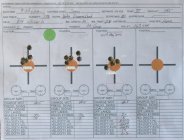Ccrider
Gold $$ Contributor
The real question is about the return on investment of time. Everyone must choose for themselves how much time they're willing to spend doing things such as pointing bullets, and whether it's worth the amount of time it takes. Trimming meplats will lower bullet BC slightly as compared to the reported [box] value, subsequently pointing them will then increase it above the box value. However, pointing bullets is not solely about increasing the BC; it's also about making the BC more consistent/uniform.Thank you for explaining @Ned Ludd. I was not catching the distinction between trimming and pointing. Maybe some day I will be able to test the effects of pointing vs trimming to the same size and then pointing back shooting them straight out of the box. I bet someone has already done that.
Trimming doesn’t change the ogive radius, only its arc length…The issue associated with trimming bullets all to the same length before pointing is that they will not have the same ogive radius, and the diameter of the meplats will not all be the same.
Never said it did. Bullets of different nose length by definition have a different ogive radius, i.e. shortest vs longest from a single Lot. If you trim a bunch of bullets of different starting lengths all to the same length, just so you can point and shoot them together, they will not necessarily end up with the same ogive radius, even though their lengths may be uniform. Length sorting first will improve that.Trimming doesn’t change the ogive radius, only its arc length…
Please clarify what is meant by the statement “The issue associated with trimming bullets all to the same length before pointing is that they will not have the same ogive radius”Never said it did. Bullets of different nose length by definition have a different ogive radius, i.e. shortest vs longest from a single Lot. If you trim a bunch of bullets of different starting lengths all to the same length, just so you can point and shoot them together, they will not necessarily end up with the same ogive radius, even though their lengths may be uniform. Length sorting first will improve that.
In my hands with the extreme longest and shortest bullets within a given Lot#, the primary length difference occurs within the nose region. That means the ogive radii will likely not all be the same, because if they were, the meplats of the longest bullets would have to be noticeably smaller in diameter than the shortest bullets. In other words, if we're only talking about a difference in arc length rather than ogive radius, longer bullets would be expected to have a longer and "pointier" nose if the arc length was simply extended as compared to the shorter bullets. Except that they aren't. This concept is easiest to visualize when comparing the very longest and shortest bullets from a given Lot#. That suggests to me that the ogive radii of longer bullets in a batch isn't necessarily exactly the same as for the shorter bullets.Please clarify what is meant by the statement “The issue associated with trimming bullets all to the same length before pointing is that they will not have the same ogive radius”
If the bullets are formed in the same die, how could they have a different ogive radius (beyond normal manufacturing variation)? The formed bullets OAL can vary based on the length of the incoming jackets.
Chapter 3, Page 83 in Bryan Litz’s book “Modern Advancements in Long Range Shooting, volume II”Thank you for explaining @Ned Ludd. I was not catching the distinction between trimming and pointing. Maybe some day I will be able to test the effects of pointing vs trimming to the same size and then pointing vs shooting them straight out of the box. I bet someone has already done that.
The best custom bullets vary in OAL. I am seeing as much as .015 variances. This variance in length impacts seating depth and theoretically, how far each bullet goes into the lands. I have two questions. For those of you that sort based bullet length, how do you sort them.
Does the difference in bullet length show up on the target?



Yes it does " point up" the bullet. : https://www.whiddengunworks.com/bullet-pointing-die-system-2/So the dies do not actually “point”?

